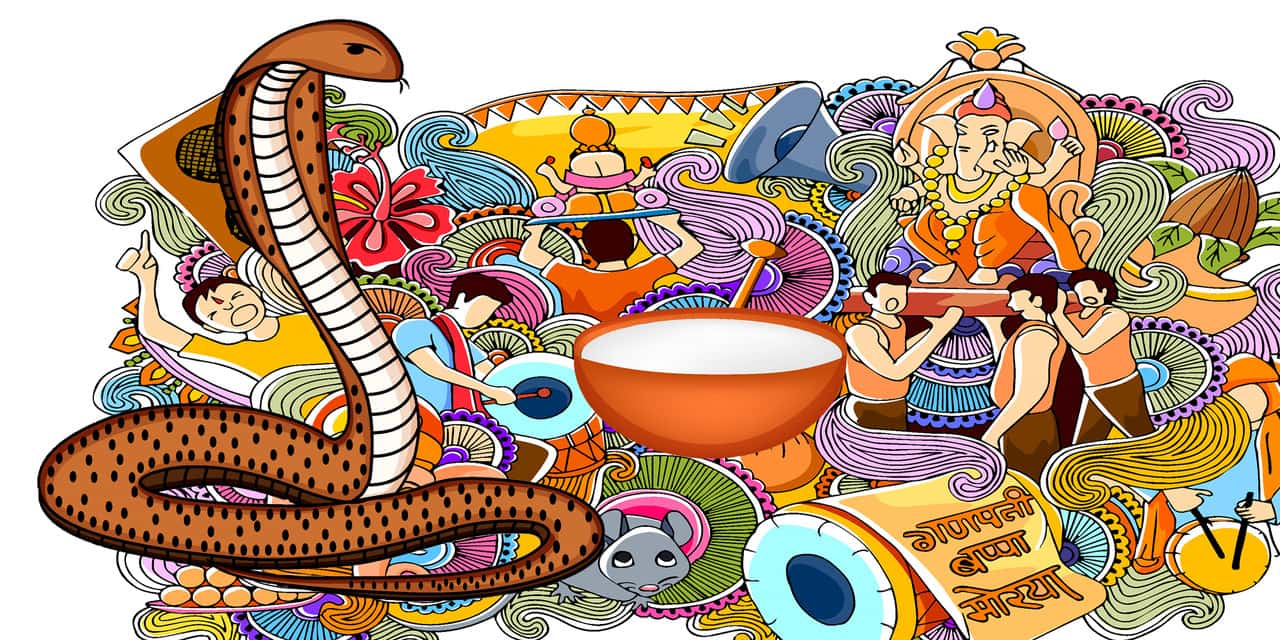
Nag Panchami, which is celebrated every year on the day of Shravan Shukla Panchami, is being celebrated today as per tradition by worshiping the snake and sticking it on the main door of the house. There is a religious belief that by sticking a picture of a snake in this way, the creatures including snakes, cobras, and scorpions will not cause grief in the house throughout the year, and also the fear of fire, clouds, and lightning can be avoided.
Prof. Dr. Ram Chandra Gautam, former chairman of the Nepal Panchang Adjudicating Committee and a theologian, informed that the decision was taken today as the Panchami is considered auspicious for the Panchami Nag Puja with the date and Shashti at sunrise. The practice of snake worship dates back to the Vedic period. According to Vedic beliefs, the serpent is considered the king of snakes. If the snake is angry, there is a lack of water, so there is a tradition of worshiping the snake to make it happy.
As mentioned in the Varaha Purana, Brahma is associated with Nagraj on Shravan Shukla Panchami and is also famous for snake worship. There are snakes in every house. The tradition of snake worship has been continued in the religious belief that if the snake sitting under the foundation of the house gets angry, the foundation of the house will be destroyed.
The practice of considering the serpent as Vishnu and Shiva has been around since Vedic times. Since Lord Shiva wears a serpent garland and Lord Vishnu sleeps on the water of the rest of the serpent under the umbrella of the fan, both gods are considered as serpents.
Lord Ganesha, who has the right of first worship, has a snake in one hand. Born as an incarnation of Lord Vishnu, Sri Ramachandra's brother Laxman and Krishna's brother Balaram are also considered as incarnations of Sheshnag. The story is told in various Puranas that both of them were born to help Shri Ram and Shrikrishna, who were born as incarnations of Lord Vishnu to destroy the evil and protect the righteous.
The story of Lord Krishna's suppression of Kalinaga in his childhood is described in various Puranas. Born as the ninth incarnation of Lord Vishnu, the statue of Buddha has a serpent-shaped figure on its head. Matsyendranath has a garland of Karkotak snakes around his neck. Jain Tirthankars also have a spiral crown on their heads.
The scriptures mention that Panduputra Arjuna and Chandragupta II married a serpent girl. The belief that Lakshmi resides in the house where the snake is worshiped has been ingrained in our society since time immemorial.
There are various legends about how and why Nag Panchami was celebrated. One of which is the famous legend. While a farmer was digging his field, he found three baby snakes and killed them. When the mother of the child came looking for food, she became angry with the farmer for killing all her children. Angered, Nagini immediately went to the farmer's house and killed his wife and two sons.
Coincidentally, the farmer's daughter was out of the house and managed to escape. After searching for the farmer's daughter, Nagini found her on the road and tried to kill her. After the farmer's daughter begged him in many ways not to kill her, he begged her to give him milk and milk. Nagini kindly released the farmer's daughter.
The farmer's daughter, who was happy to escape death, worshiped Nagini and gave her milk in a bowl. Pleased with the farmer's daughter's prayer, Nagini asked for a bridegroom, saying, "I am pleased with your devotion." Pleased, Nagini saved the farmer's family. It is believed that the day when Nagini saved the farmer's family was Shravan Shukla Panchami, which means today.
Guru Gorakhnath sat in the seat of nine snakes and practiced asceticism for twelve years. The scriptures also mention that after the arrival of Guru, after the rise of Gorakhnath, the serpent was freed and rained water.
The most precious gem in the world is worn on the head by a snake. Nag loves the fragrance and music of Shrikhand. There is even a belief that Nag Shravan Shukla Panchami, which lives inside the dulu in summer, comes out today due to the coldness of the rainy season.
Even though there are twelve names of snakes, there is a tradition from time immemorial to worship eight snakes of eight clans. Eight serpents including Ananta, Vasuki, Padma, Mahapadma, Takshak, Kulir, Karkat and Shankha are worshiped by Brahmin priests today and pasted on the door of the house. Today, it is believed that snakes should not be mined in the fields and snakes, reptiles and other reptiles should not be killed.
Today, Nagpokhari and Toudah in Kathmandu, Siddhapokhari in Bhaktapur, Nagdaha, Kund and Nag places all over the country are specially worshiped and offerings of cow's milk, Akshata, Dubo, Kheer and Roti are offered with respect to the snake.
It is believed that the sages established the ritual of worshiping the snake species after scientifically confirming from the research that the poisonous substances in nature are not absorbed by the creatures including Nag, snake, and other species including humans.





